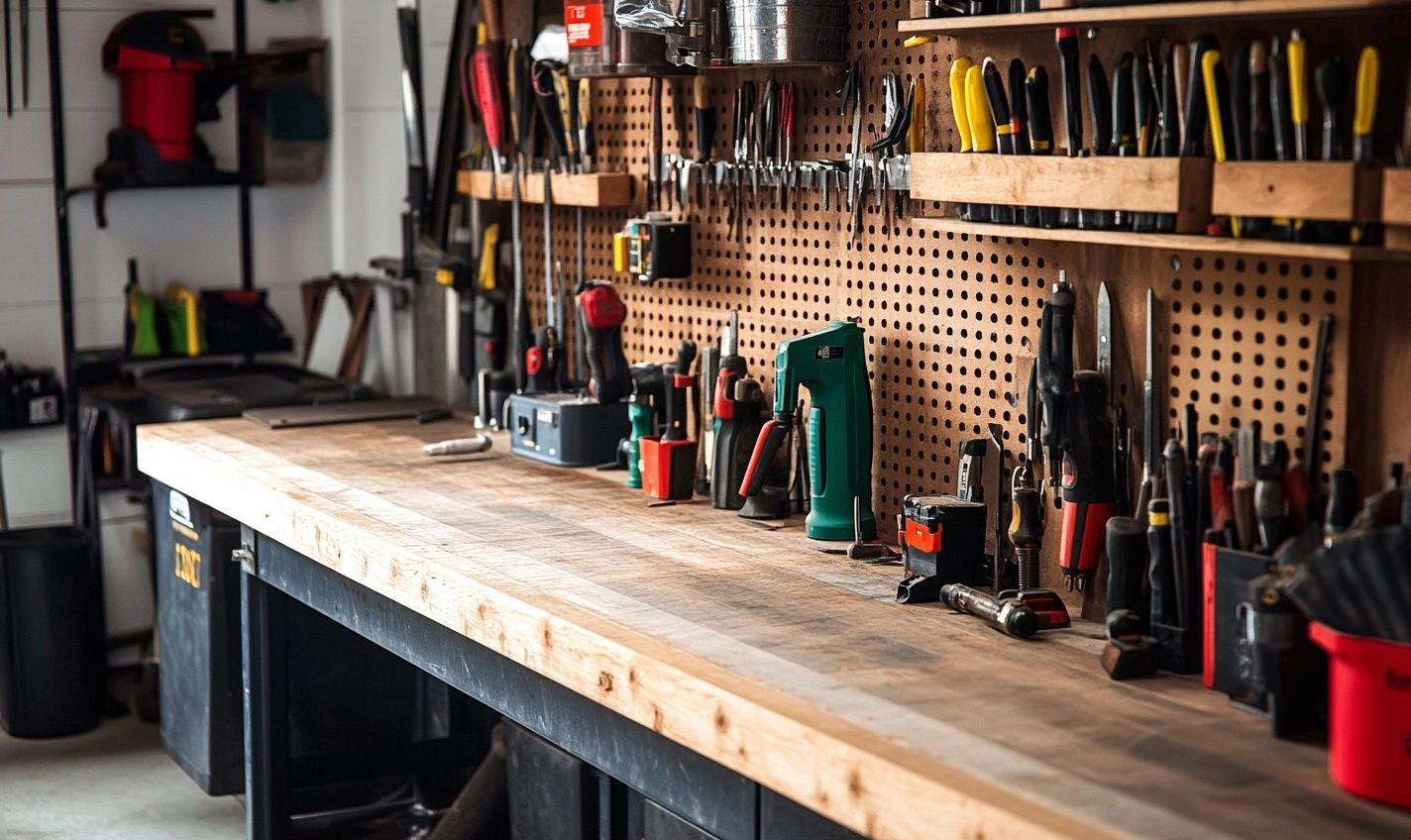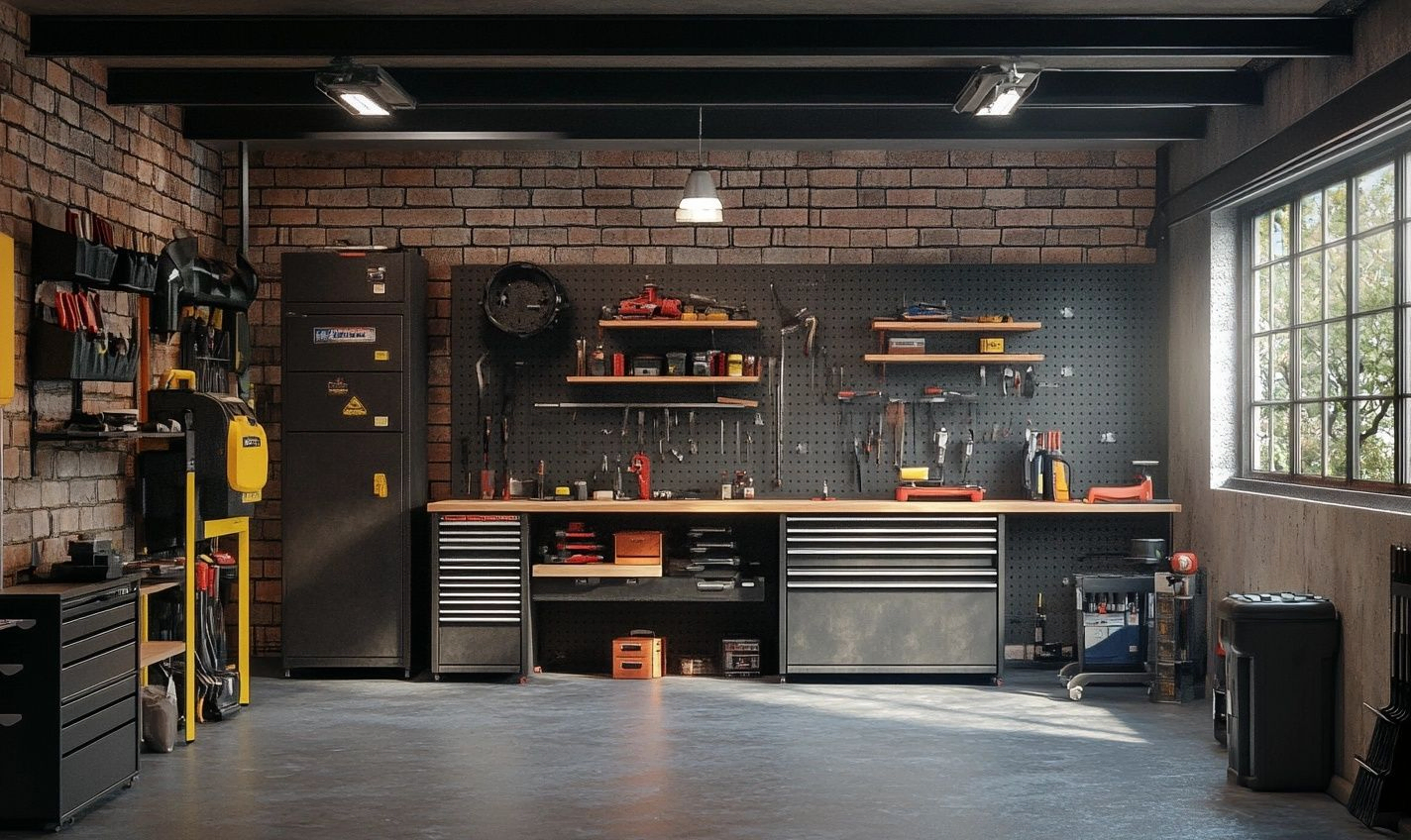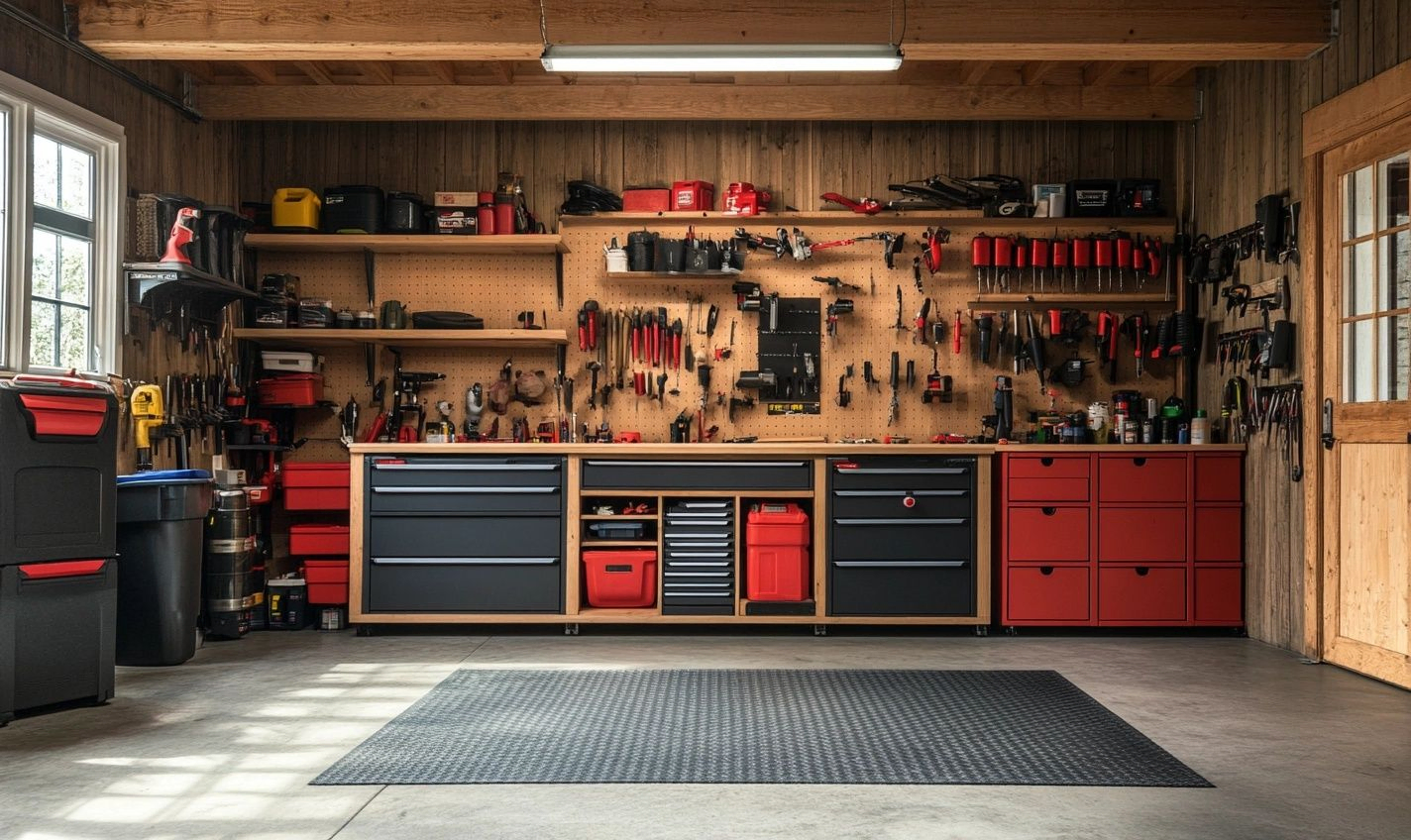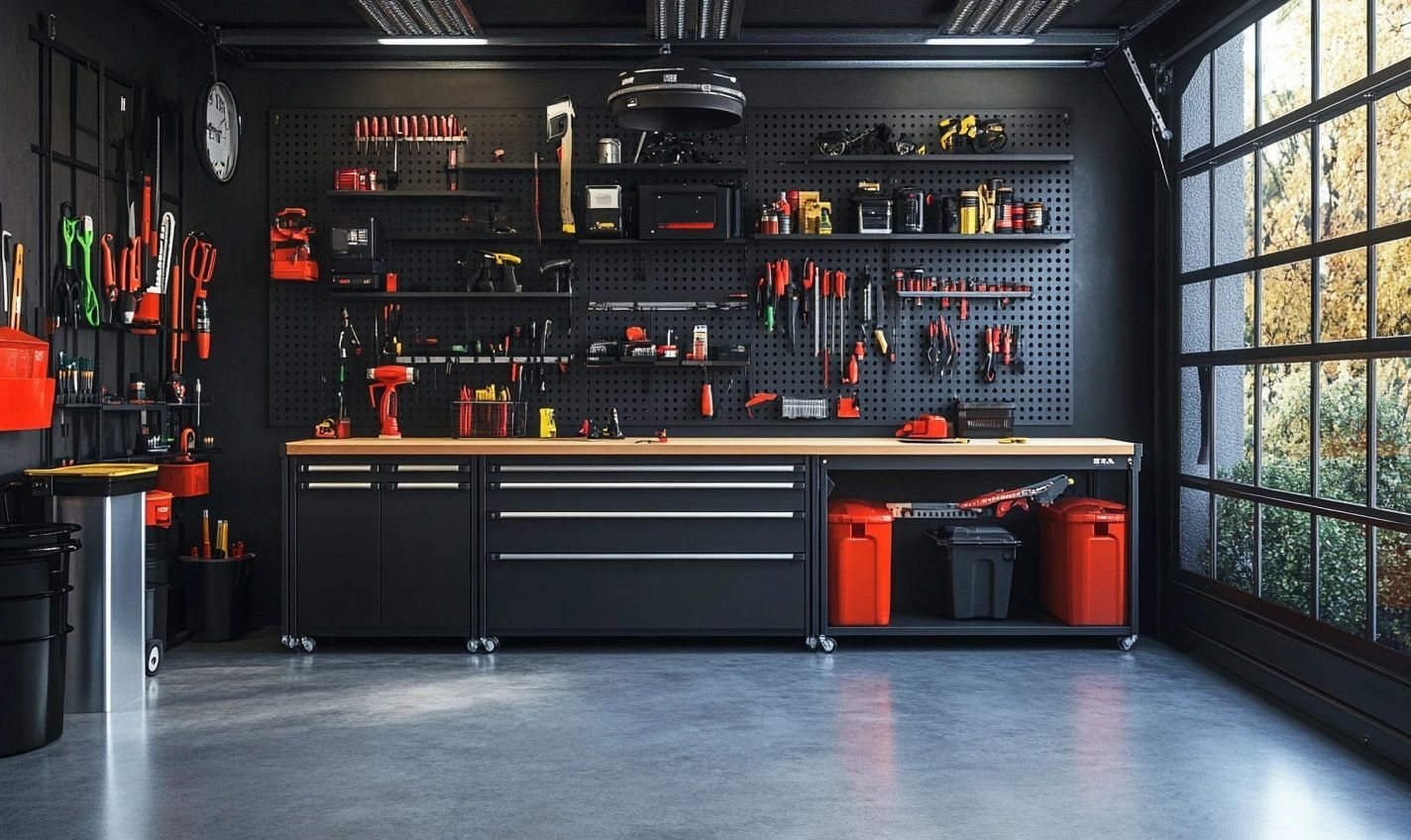Welcome to our comprehensive guide on maintaining and caring for your workbench, a crucial asset in any garage workshop. As an expert in the field, I understand the importance of keeping your workbench in top condition to ensure it remains a reliable and efficient workspace for all your projects.
Your workbench is where creativity meets functionality, where ideas take shape into tangible creations. Regular maintenance routines to extend its lifespan and optimize its performance are necessary to make the most of this essential workspace.
Proper care for your workbench, from simple cleaning practices to more in-depth checks and adjustments, will benefit your projects and enhance your overall workshop experience. Whether you’re a seasoned craftsman or a DIY enthusiast, these tips will help you keep your workbench in prime condition for years.
So, let’s delve into the world of workbench maintenance together, explore the best practices for preserving this cornerstone of your workshop, and discover the satisfaction of working on a well-kept and organized work surface.

Inspecting Your Workbench Regularly
Just like your car needs regular maintenance to perform at its best, your workbench also requires care and attention to ensure it remains in top condition. Properly maintaining and caring for your workbench can extend its lifespan, improve its functionality, and enhance your overall workshop experience.
Why Regular Inspection is Crucial
Our workbenches are the foundations of our creativity and productivity. But what if that very foundation starts to wear and crack? Regular inspection of your workbench is vital to catch any potential issues early on before they escalate into costly problems. It’s like giving your trusty old workhorse a check-up to keep it running smoothly.
Simple Steps for Workbench Inspection
Inspecting your workbench doesn’t have to be a tedious task. Here are some simple steps you can follow to ensure your workbench stays in top shape:
- Check for any cracks, dents, or warping in the work surface.
- Inspect the legs and support structure for stability and signs of damage.
- Ensure all fasteners and hardware are tight and secure.
- Clean and remove any debris or clutter that may have accumulated.
Benefits of Regular Maintenance
By conducting regular inspections of your workbench, you not only prevent potential accidents but also prolong its life. A well-maintained workbench ensures a safe and efficient workspace for all your projects, allowing you to focus on your craftsmanship without worrying about equipment failure.
Remember, a small crack overlooked today could become a significant structural issue tomorrow. Stay vigilant and show your workbench some love by inspecting it regularly. Your projects will thank you for it!

Cleaning and Organizing Your Work Area
Keeping your garage workshop tidy and well-maintained is crucial for a productive and safe working environment. Cleanliness and organization are critical factors in maintaining and caring for your workbench.
Declutter Regularly
Just like a cluttered desk affects your concentration, a cluttered workbench can hinder your productivity. Declutter your work area for a few minutes every week.
- Remove any unnecessary tools or materials.
- Put away items in their designated storage spaces
- Dispose of any damaged tools or materials
Clean Your Workbench Surface
After completing a project, make it a habit to clean your workbench surface. Dust, debris, and spilled liquids can accumulate over time, affecting the quality of your work.
- Use a vacuum or a brush to remove dust and debris
- Wipe down the surface with a damp cloth and mild detergent
- Dry the workbench thoroughly to prevent moisture damage
Organize Your Tools and Materials
Proper organization of tools and materials enhances work efficiency and reduces the risk of accidents or injuries caused by misplaced items.
- Invest in storage solutions such as tool chests, shelving units, or pegboards.
- Categorize your tools and materials to locate them when needed easily
- Label storage containers for quick identification
By incorporating these simple cleaning and organizing practices into your routine, you can create a well-maintained and functional workbench that will support your projects effectively. Remember, a cluttered and messy workspace can clutter your mind, hindering your creativity and productivity. Take the time to care for your work area, and you’ll find yourself working more efficiently and enjoying the process even more.

Protecting Your Workbench from Moisture and Corrosion
Do you want your workbench to stand the test of time? Ensuring that it remains free from moisture and corrosion is essential. By taking proactive steps to protect your workbench, you can prolong its lifespan and maintain its functionality. Let’s dive into some practical strategies to shield your beloved workbench from the damaging effects of moisture and corrosion.
Inspecting Your Workbench Regularly
Regular inspection is crucial in identifying any signs of moisture or rust. Look out for any discoloration, rust spots, or warping on the surface of your workbench.
Cleaning and Organizing Your Work Area
Keep your workspace clean and organized to prevent moisture buildup. Clutter can trap moisture, leading to potential corrosion of your workbench.
Proper Storage of Tools and Materials
- Store tools in a dry area to prevent rust formation.
- Use rust-resistant containers for storing materials.
- Avoid leaving wet items on the workbench.
Adjusting and Calibrating Your Workbench
Ensure your workbench is leveled correctly and adjusted to prevent water pooling, which may lead to corrosion.
Applying Protective Coatings and Finishes
Consider applying a protective coating such as rust-resistant paint or clear sealant to shield your workbench from moisture and corrosion.
Replacing Worn-Out Parts and Accessories
Proactively replace worn-out parts or accessories to prevent further damage to your workbench.
Enhancing Safety Measures in Your Workshop
- Invest in a dehumidifier to control moisture levels in your workshop.
- Install a ventilation system to promote air circulation and prevent condensation.

Proper Storage of Tools and Materials
Keeping Your Workspace Organized
Having a clutter-free work area is essential for maintaining the longevity of your workbench. Properly storing your tools and materials improves efficiency and prevents accidents and damage.
Utilizing Storage Solutions
Invest in quality storage bins, shelves, and cabinets to keep your tools and materials organized and within reach. This will save time searching for items and make your workspace more visually appealing.
Sorting and Labeling
Use clear labels and dividers to categorize your tools and materials effectively. Sorting items by size, type, or frequency of use can streamline your workflow and make it easier to find what you need quickly.
Implementing a Maintenance Schedule
Set aside time each month to reassess your storage system and make any necessary adjustments. Regularly decluttering and reorganizing your workspace will help you stay on top of maintenance tasks and prevent future issues.
And remember, a well-organized garage workshop is like a well-oiled machine—efficient, productive, and a joy to work in. By following these storage tips, you can ensure that your workbench remains in top condition for years.

Adjusting and Calibrating Your Workbench
Like tuning a guitar before a big performance, maintaining and caring for your workbench is crucial for a smooth and successful workflow in your garage workshop. It’s the beating heart of your creative space, where all your projects come to life.
Ensuring Precision and Accuracy
Wondering how to keep your workbench in tip-top shape? Making sure everything is calibrated and adjusted correctly is critical. Here’s how:
– Align your workbench surface to ensure that it is level.
– Check and adjust the height of your workbench to prevent strain on your back and arms.
Fine-Tuning for Efficiency
Like a well-oiled machine, your workbench needs fine-tuning to operate at its best. Here are some tips to keep it running smoothly:
1. Tighten any loose bolts or screws that may affect stability.
2. Lubricate moving parts such as drawers and vises for seamless operation.
Proper calibration and adjustment of your workbench ensure that every cut, drill, or hammer strike is precise and efficient. It’s like finding the perfect balance in a dance routine – everything flows effortlessly.

Applying Protective Coatings and Finishes
Let’s talk about giving your workbench some love with a fresh coat of protection. Like how we care for our skin, your workbench also needs some shielding. Maintaining and caring for your workbench means ensuring it stays in top-notch condition for all your projects.
Choose the Right Finish
First, select a protective coating that suits your workbench material. Oils, paints, varnishes, and waxes are all great options for safeguarding your work surface. But make sure to check their compatibility with your bench type before application.
Application Techniques
When coating your workbench, remember patience is vital. Take your time to apply the finish evenly, allowing each layer to dry completely before adding the next. A well-coated bench equals long-lasting protection.
Regular Maintenance
Like a car needs an oil change, your workbench needs regular maintenance. Consider reapplying the protective finish to keep your bench looking fresh and shielded from wear and tear.
- Inspect your workbench regularly to identify any areas that need touch-ups.
- A gentle cleaner removes dirt and debris before applying a new finish.
- Don’t forget the edges and corners that might be prone to more wear.
Remember, a well-cared-for workbench is like a reliable old friend, always there to support you in your craft. So, give it the attention it deserves, and it will serve you well for years to come!
Replacing Worn-Out Parts and Accessories
Just like a car needs a tune-up now and then, your workbench also requires some love and care to keep it in top shape. One crucial aspect of maintaining and caring for your workbench is ensuring that any worn-out parts or accessories are promptly replaced.
Stay Sharp with Regular Tool Inspections
Power tools like saws and drills are the heart and soul of any workshop. Inspect these tools regularly to see if any parts are worn out and need replacement.
Your workbench is only as suitable as the tools you use. Keeping them in top condition ensures that your projects will turn out just as you envision them.
Invest in Quality Accessories
Accessories like bench dogs, clamps, and vises are essential for your workbench’s functionality. If any of these accessories show wear and tear, it’s time to invest in new ones.
Think of it like upgrading to a new smartphone – you wouldn’t settle for a cracked screen or malfunctioning buttons, would you?
Don’t Ignore Small Defects
Even the tiniest crack in your workbench’s surface can lead to more significant problems. Please inspect for any defects regularly, no matter how insignificant they may seem.
Remember, a minor issue today could become a significant headache tomorrow if left unaddressed.
Benefits of Replacing Worn-Out Parts
- Improved efficiency and accuracy in your projects
- Enhanced safety for you and your workspace
- Prolonging the lifespan of your workbench
- Boosting your overall productivity and enjoyment in the workshop
Enhancing Safety Measures in Your Workshop
Safety should always be a top priority in your garage workshop. Taking proactive measures can ensure a secure working environment for yourself and others. Let’s explore some critical steps to enhance safety in your workshop.
Always Maintain Good Lighting:
Proper lighting is crucial in a workshop setting. It helps you see clearly and reduces the risk of accidents. Invest in bright overhead lighting and task lighting for focused areas.
Keep Emergency Equipment Handy:
Accidents can happen at any time. Ensure you have a first aid kit, fire extinguisher, and emergency contact numbers in your workshop. Being prepared can make a significant difference in emergencies.
Wear Personal Protective Equipment (PPE):
Wear the appropriate PPE to protect yourself from potential hazards. This includes safety goggles, ear protection, gloves, and a dust mask. Your well-being is non-negotiable.
Maintain a Clean and Clutter-Free Workspace:
- Clutter increases the likelihood of trips and falls.
- Regularly declutter your workbench and floor space.
- Dispose of waste materials promptly.
Secure Loose Cords and Cables:
Tripping over cords and cables is a joint workshop hazard. To prevent accidents, keep them organized and secured along walls or ceilings. Velcro straps or cable ties can be handy solutions.
Establish Safety Rules:
- Set clear guidelines for workshop usage.
- Ensure everyone adheres to safety protocols.
- Regularly communicate and reinforce safety practices.
Remember, creating a safe workshop environment is a continuous process. You can enjoy a secure and productive workspace by incorporating these safety measures into your routine. Stay safe, and happy woodworking!
Conclusion
Maintaining and caring for your workbench is crucial for ensuring its longevity and performance in your garage workshop. Following the essential tips in this blog post, you can keep your workbench in top condition for years.
Regular cleaning, inspection, and lubrication of your workbench will prevent rust, corrosion, and wear and tear. Additionally, proper storage of tools and materials will help maintain a clutter-free workspace and extend the life of your workbench.
Remember to check your workbench regularly for signs of damage or issues that must be addressed. By addressing problems early on, you can prevent more costly repairs or replacements.
Investing time and effort in maintaining and caring for your workbench will benefit your projects and enhance your garage workshop experience. A well-maintained workbench is a reliable and functional tool that will support your crafting and DIY endeavors for years.
Frequently Asked Questions (FAQs)
How often should I maintain my workbench?
It is recommended that you perform maintenance on your workbench at least once a year or as needed, depending on usage.
What are some ways to protect my workbench from rust?
You can protect your workbench from rust by applying a rust-resistant coating, keeping it dry, and regularly wiping down metal parts with a rust inhibitor.
How can I prevent warping of the workbench surface?
Place the workbench in a well-ventilated area away from moisture and direct sunlight to prevent warping. Use coasters or mats under heavy items to distribute weight evenly.
What is the best way to clean a workbench?
Wipe down the workbench surface for general cleaning with a mild detergent and water solution. A mixture of vinegar and water can be effective for tougher stains.
How should I store tools on my workbench?
Consider installing pegboards, drawers, or shelves to organize and store tools efficiently. Keep frequently used tools within easy reach to optimize workflow.
Can I refinish my workbench if it gets damaged?
Yes, you can refinish your workbench if it gets damaged. Sand down the surface, apply a new finish or protective coat, and allow it to dry thoroughly before use.